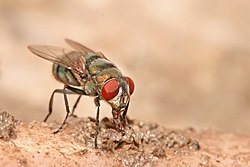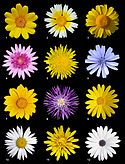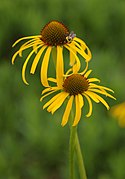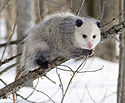Portál:Biologie/Obrázek dne/2009-01
1
2
3
4
[[Image:|center|250px]]
5
[[Image:|center|250px]]
6
[[Image:|center|250px]]
7
[[Image:|center|250px]]
8
[[Image:|center|250px]]
9
[[Image:|center|250px]]
10
11
12
13
14
15
16
17
18
19
20
21
22
23
24
25
26
27
28
29
30
Média použitá na této stránce
Autor: Alvesgaspar, Tony Wills (10), Licence: CC BY-SA 3.0
A poster of twelve different species of flowers of the family Asteraceae, belonging to the three most representative subfamilies: Asteroideae, Cichorioideae and Carduoideae:
- Yellow Chamomille - Anthemis tinctoria (Asteroideae)
- Crown Daisy - Glebionis coronarium (Asteroideae)
- Corn Marigold - Coleostephus myconis (Asteroideae)
- Marguerite - Argyranthemum frutescens 'Bridesmaid' (Asteroideae)
- Sow Thistle - Sonchus oleraceus (Cichoireideae)
- Chicory - Cichorium intybus (Cichoireideae)
- Treasure Flower - Gazania rigens (Cichoireideae)
- Galactites - Galactites tomentosa (Carduoideae)
- Field Marigold - Calendula arvensis (Asteroideae)
- Ox-eye daisy – Leucanthemum vulgare (Asteroideae)
- Common Hawkweed - Hieracium lachenalii (Cichoireideae)
- Cape Daisy - Osteospermum ecklonis (Asteroideae)
Autor: Fastfission on en.wikipedia (or de.wikipedia), Licence: CC BY-SA 3.0
Made from an fMRI scan I had done. Goes from the top of my brain straight through to the bottom. That little dot that appears for a second on the upper-left hand side is a vitamin E pill they taped to the side of my head to make sure they didn't accidentally swap the L-R orientation.
To clarify, this animation was made by Fastfission and is based on Fastfission's brain. This is what makes a Wikipedian tick. -- Solipsist
Autor: Richard Bartz, Munich Makro Freak, Licence: CC BY-SA 2.5
Description: Cypress Spurge (Euphorbia cyparissias) is a plant in the genus Euphorbia, which is native to Europe.
Autor: Photo by and (c)2008 Derek Ramsey (Ram-Man). Co-attribution must be given to the Chanticleer Garden., Licence: CC-BY-SA-3.0
Picture of a flower head of an Allium en 'Lucy Ball', a hybrid of Allium elatum en and Allium aflatunense en . Photo taken in the Pond Garden in Bed 1, 2 3, or 4 at the Chanticleer Garden where the species was identified.
Autor: Photo by and (c)2007 Derek Ramsey (Ram-Man), Licence: GFDL 1.2
Photograph of a bee on a Yellow Conefloweren (Echinacea paradoxa en ). Photo taken at the Tyler Arboretum where it was species identified.
| |||
Autor: en:User:Drgnu23, subsequently altered by en:user:Grendelkhan, en:user: Raul654, and en:user:Solipsist., Licence: CC BY-SA 3.0
Conversion of a DICOM-format X-ray from a patient of en:User:Drgnu23, a ten year old male. This is the patient's left hand, posterior-anterior projection. Identifying tags and such have been stripped. The image is his, released under the GFDL. The image was subsequently altered by en:user:Grendelkhan, en:user: Raul654, and en:user:Solipsist.
Autor: Photo by and (c)2007 Derek Ramsey (Ram-Man). Co-attribution must be given to the Chanticleer Garden. Both parties have shared, contractual copyright control., Licence: CC-BY-SA-3.0
A picture of a lily flower (Lilium en 'Citronella'). Photo taken at the Chanticleer Garden where its species was identified.
Autor:
André Karwath aka Aka
, Licence: CC BY-SA 2.5This image shows a Large-flowered Hemp-nettle blossom (Galeopsis speciosa). Thanks to Franz Xaver for identifying this plant.
Bison bison. Original caption: "scientists are helping users of American rangelands meet the challenge of managing multiple uses sustainably.")
Autor: Fir0002, Licence: GFDL 1.2
A fishing spider in the family Pisauridae and genus Dolomedes with two of its legs missing. Most likely some predator (a bird or given its habitat a large fish or frog) grasped the spider by the missing limbs which were jettisoned by the spider in response. Taken in Swifts Creek, Victoria, Australia in April 2007
Autor: Christian Mehlführer, User:Chmehl, Licence: CC BY 2.5
Gray "timber wolf", picture taken in Zoo Schönbrunn, Vienna, Austria.
Autor:
André Karwath aka Aka
, Licence: CC BY-SA 2.5This image shows a few dried mushrooms.
Autor: benjamint444, Licence: CC-BY-SA-3.0
An Australian Lace Monitor more commonly known as a Goana (Varanus varius)
Citrus fruits
More than 70 percent of all citrus fruits grown in the United States are varieties developed by the ARS citrus breeding program.
In Florida, the ARS has developped citrus varieties that are higher yielding with increased disease resistance, better color, and longer shelf life. A major success story is Ambersweet, a cold-hardy citrus that's been approved for use in orange juice products. Because it withstands Florida's occasional cold snaps that can ruin most citrus, Ambersweet is being widely planted in the Sunshine State. It took 20 years of patient breeding to develop it, but the payoff is huge.
If there's usually a grapefruit in your shopping cart, you may already have met up with a favorite ARS-created variety. It's a red-fleshed, thin-skinned, seedless grapefruit that was developed and released in 1987. Since then, over 4 million Flame nursery trees have been propagated in Florida. No other grapefruit variety has ever been so widely accepted and planted.
Orange sections can now be prepared by a patented ARS process that uses commercially available food-grade enzymes. The process also removes the bitter white portion of grapefruit peel, eliminating hand-peeling and allowing more precise portion control. And the prepeeled fruit is ideal for school lunch programs and restaurants.
© Hans Hillewaert, CC BY-SA 4.0
Portrait of a Black-faced Impala ram between Olifantsbad and Aus, in Etosha National Park, Namibia.
Autor: Muhammad Mahdi Karim, Licence: GFDL
An Old World screw-worms Chrysomya albiceps, feeding on rotting meat. Picture taken in Dar es Salaam, Tanzania
Autor: Brocken Inaglory, Licence: CC BY-SA 3.0
Gold dust day gecko licking nectar from Bird of Paradise flower. The image was taken at Kona, Hawaii.














































